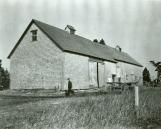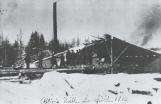1
The land of this part of Queens County was extremely attractive to immigrants from the British Isles in the early 19th century. The prospect of owning a few acres and carving out a new life appealed to those struggling for survival in less than ideal surroundings in England, Scotland and specifically Ireland. The river valleys offered rich farmland while the hardwood ridges and deep forests provided an abundance of wood and game. Cows, horses, sheep, fields of grain and fruit orchards spread across the region. Dotted in between were general stores, lumber mills and other craftsmen and cottage industries.2
George McKinney Farm, Summer Hill, 19521952
Summer Hill
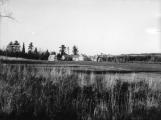 Credits:
Credits:Base Gagetown Community History Association
3
The George McKinney Farm at Summer Hill illustrates the agricultural ideal. A neat and well maintained house with a comfortable porch, sturdy outbuildings and a large barn, all of which is surrounded by pasture, fields and close to the forest.5
Some farms were larger than others. Much depended upon the amount of land, its location and its quality. This barn at the Sutton Farm, Summer Hill, indicates a very prosperous establishment.6
Cow Bell, about 1900 Short Family, New Jerusalem1900
New Jerusalem
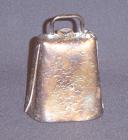 Credits:
Credits:Queens County Museum Collection
7
This homemade brass cow bell is from the Short Farm, New Jerusalem.8
Raymond Scott Milking a Jersey Cow, Summer Hill, about 19501950
Summer Hill
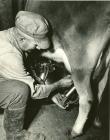 Credits:
Credits:Queens County Museum Collection
9
This photograph shows Raymond Scott, Summer Hill, milking one of his prized Jersey cows in 1952. Farmers like Scott were not reluctant to experiment and purchase the latest technologies. Note the shining metal of the milking machine.10
Fred Lacey Picks Up Cream from Lydia Scott, Summer Hill, about 19501950
Summer Hill
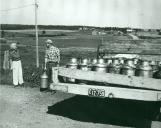 Credits:
Credits:Queens County Museum Collection
11
The establishment of the Harvey Creamery and its subsequent expansion into Queens County provided a ready market for the milk and cream produced on the numerous farms. In this photograph, Fred Lacey is picking up cream from Lydia Scott, Summer Hill.13
While farming formed the core industry of the area, the abundant forest provided a livelihood for others. Numerous sawmills made use of the vast stands of timbers. The Colliers Mill, pictured here, was located in Lawfield, about 10 kilometers from the village of Gagetown.14
Lawfield Full Gospel Church, 19521952
Lawfield
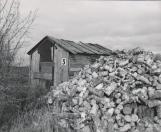 Credits:
Credits:Base Gagetown Community History Association
